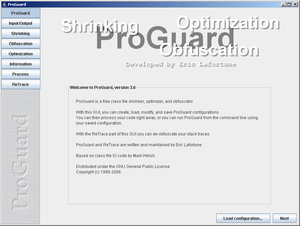ProGuard (software)
ProGuard is an open source command-line tool that shrinks, optimizes and obfuscates Java code. It is able to optimize bytecode as well as detect and remove unused instructions.[3] ProGuard is free software and is distributed under the GNU General Public License, version 2.[2]
 ProGuard GUI | |
| Developer(s) | Eric P.F. Lafortune[1] |
|---|---|
| Stable release | 6.1.1
/ June 2019 |
| Repository | |
| Written in | Java |
| Operating system | Cross-platform |
| License | GPLv2.0[2] |
| Website | www |
ProGuard is distributed as part of the Android SDK and runs when building the application in release mode.[4]
Features
Obfuscation
ProGuard obfuscates Java and Android programs by renaming classes, fields, and methods using meaningless names, making it harder to reverse-engineer the final application.[5]
Optimization
Besides removing unused instructions from the compiled bytecode, ProGuard optimizes it using techniques such as control flow analysis, data-flow analysis, partial evaluation, static single assignment, global value numbering, and liveness analysis.[5]
ProGuard can remove many types of unused and duplicated code, perform over 200 peephole optimizations, reduce variable allocation, inline constant and short methods, simplify tail recursion calls, remove logging code, among others.[5]
References
- "Eric Lafortune home page". Retrieved November 24, 2015.
- "ProGuard license page". February 2, 2015. Retrieved November 24, 2015.
- "ProGuard overview (official page)". February 2, 2015. Retrieved November 24, 2015.
- "Shrink your code and resources". Retrieved June 10, 2018.
- "ProGuard FAQ". February 2, 2015. Retrieved November 24, 2015.